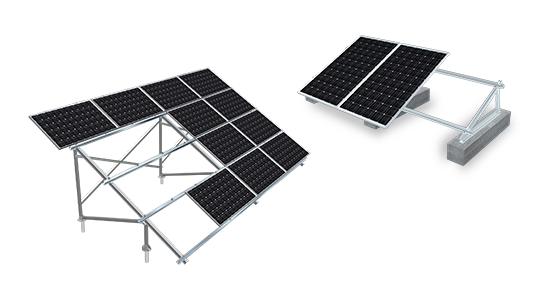Installation Considerations for Flat Roof Solar Mounting System
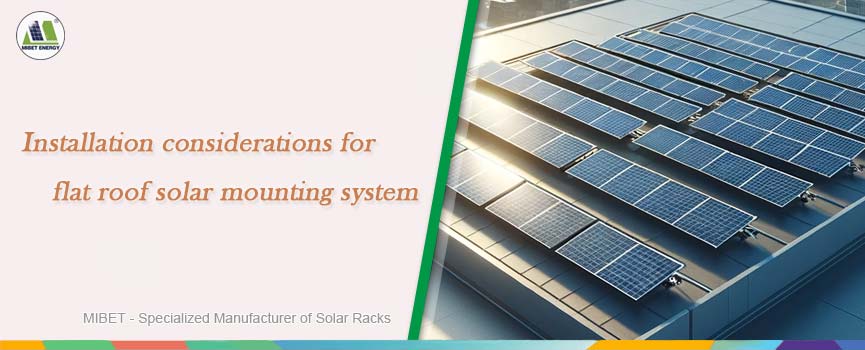
Solar energy is an excellent choice for homes and businesses with various roof types, including flat roofs. While flat roof installations have some unique considerations, the benefits of solar power remain significant. In this article, we will explore several crucial considerations for installing a solar mounting system on a flat roof to ensure efficiency, durability, and safety.
Can You Install Solar on a Flat Roof?
You can install a solar panel array on your flat roof. Flat roofs are often a good choice for solar panel installations because, when installed correctly, the panels can receive an optimal amount of sunlight.
However, you need to consider the additional space required. The panels should be placed at a distance from parapet or perimeter walls to prevent shading. Moreover, flat roof systems usually use ballast to anchor the panels against strong winds or harsh weather, which adds to the weight your roof must support.
It's important to verify if your flat roof can handle the weight of the solar panel system. The total weight depends on the size and quantity of panels you plan to install.
Flat Roof Solar Mounting System Type
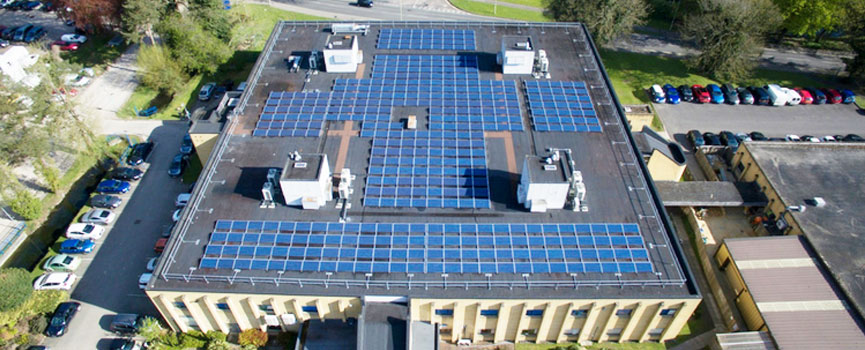
Solar Ballasted Systems
Ballasted systems are the most common type of flat roof solar mounting system. Unlike traditional racking systems that require drilling or punching holes into the roofing membrane, ballasted systems utilize a weight-based approach to secure the panels, ensuring both ease of installation and long-lasting protection for your roof. Concrete blocks or other heavy materials are generally used to safeguard the solar panels against damage, thereby obviating the need to penetrate the roof membrane.
Flat Roof Concrete Foundation Triangle Mounting System
The system employs triangular mounting frames, with the angle of these frames typically determined by the roof's specific orientation and geographical location, ensuring optimal solar gain. Instead of penetrating the roof, the triangle mounting system uses concrete blocks or other similar heavy materials as a foundation. These foundations sit directly on the roof and provide the necessary stability and weight to secure the mounting system and the solar panels in place. This approach is particularly advantageous for flat roofs where roof penetration is undesirable due to waterproofing concerns or structural limitations.
The solar mounting systems for flat roofs from MIBET have been developed with all due attention for roof and wind load, so they comply with the highest safety standards. For more information, please click here.
Optimal Panel Orientation for Flat Roof Solar
The optimum angle for flat roof solar panels depends on the location of the installation. In general, a tilt angle of 10 to 30 degrees is considered ideal for flat-roof solar panels in most climates. This angle helps to maximize sun exposure throughout the year while minimizing the impact of wind.
Here's a more detailed breakdown of the optimum tilt angle for flat roof solar panels in different regions:
● Mid-latitude regions (30-45 degrees latitude): 15-25 degrees
● Lower-latitude regions (23-30 degrees latitude): 10-20 degrees
● Higher-latitude regions (45-60 degrees latitude): 25-35 degrees
It's important to note that these are just general guidelines, and the specific optimum tilt angle for your location will depend on a number of factors, such as the local climate, shading patterns, and the availability of roof space. A qualified solar installer can help you determine the best tilt angle for your particular situation.
Wind Speed Must Be Considered for Flat Roofs
Flat roof solar mounting systems are typically designed to withstand wind speeds up to 160 km/h (100 mph). However, if you reside in an area prone to stronger winds, exceeding 180 km/h (110 mph), it's crucial to consider additional measures to ensure the stability of your solar system.
During the planning phase of your solar installation, communicate the expected wind speeds in your region to the solar structure manufacturer. This information will enable them to provide you with the appropriate flat roof solar racking system for your location. They may recommend thicker structural profiles or specific mounting methods, such as attached, ballasted, or concrete footing, to reinforce the system's wind resistance.
Furthermore, ensure that your chosen solar installers adhere to the manufacturer's guidelines and local building codes during the installation process. Proper installation techniques are essential to prevent damage to the solar modules and ensure the long-term integrity of your solar power system. By taking these precautions, you can safeguard your investment and enjoy the benefits of solar energy with peace of mind.
Flat Roof Solar Panel Installation Costs Comparable to Sloped Roofs
The cost of installing solar panels on a flat roof is comparable to that of a standard sloped rooftop installation. Labor and installation expenses typically account for around 10% of the overall cost of a solar panel system. This is partly because installing solar panels and their mounts on a steep roof requires climbing and maneuvering around the incline, which can be challenging and time-consuming.
In contrast, installing solar panels on a flat roof is a more straightforward process. Workers can freely move across the roof without the need for specialized equipment, and the materials used on flat roofs are generally more durable and can withstand the stresses of installation.
An additional advantage of flat roof solar mounting systems is that they do not require drilling holes into the roof. Sloped roof installations typically employ a "penetration mount" system, which involves drilling multiple holes to secure the racking that holds the solar panels. Flat roof systems, on the other hand, commonly utilize a "ballast system" that relies on gravity to keep the panels in place without penetrating the roof membrane.
Despite the simplified installation process, flat roof solar panel systems may sometimes require specialized equipment to optimize electricity production. Instead of laying the panels flat, installers often use angled mounts to tilt them towards the sun, ensuring maximum exposure throughout the day. This additional step can slightly increase the overall cost of a flat roof solar panel system.
Critical Considerations for Flat Roof Solar Mounting System Installation
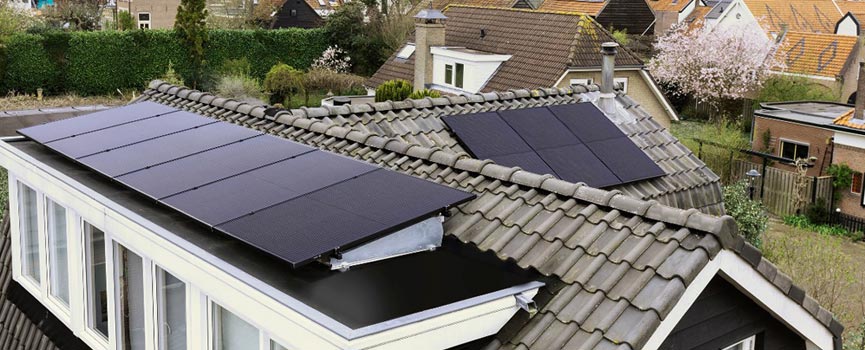
Structural Integrity of the Roof
A comprehensive structural assessment is vital before installing solar panels, to confirm if the roof can bear the extra weight of the panels and their mounting system. This step involves detailed load calculations, accounting not only for the panels and the mounting structure but also for potential additional loads due to snow and wind. In cases where the existing structure is insufficient, reinforcing the roof might be necessary to accommodate the solar setup safely.
Roof Material and Condition
The choice of the solar mounting system is significantly influenced by the type of roofing material, whether it be concrete, metal, or bitumen. It's equally important to evaluate the condition of the roof; a roof nearing the end of its lifespan may not be a suitable candidate for solar panel installation due to potential structural risks and the cost implications of replacing the roof soon after installation.
Orientation and Tilt of Panels
Achieving the correct tilt and orientation is crucial for flat roofs to maximize sun exposure and energy efficiency. This requires a strategic layout of the panels, maintaining adequate spacing between rows to prevent shading, which can significantly reduce the efficiency of the solar array.
Water Drainage
Solar installations must be planned to ensure they do not obstruct the roof's water drainage paths. Additionally, waterproofing considerations are paramount, especially around mounting points in mechanically attached systems, to prevent any potential water ingress that could damage the roof or the building structure.
Maintenance Accessibility
Sufficient space around the solar panels is essential to facilitate easy maintenance and repair activities. In many cases, installing walkways around the panels is a practical solution, offering safe and convenient access for regular maintenance, thereby enhancing the longevity and performance of the solar system.
Electrical and Safety Considerations
Proper cabling is crucial not only for system efficiency but also for safety, minimizing exposure and the risk of tripping hazards. In addition to efficient cable management, installing safety equipment like rails or anchor points is particularly important in commercial installations to ensure a safe environment for maintenance personnel.
Local Regulations and Permits
Compliance with local building codes and regulations is non-negotiable in solar panel installations. Additionally, securing all necessary permits is a critical step before commencing the installation process, as this ensures adherence to safety standards and local guidelines.
Installation Expertise
To guarantee the safety and compliance of the solar panel installation, it’s crucial to engage certified and experienced professionals. Professional installers have the expertise to handle the complex aspects of installation, ensuring that the system is set up efficiently and safely.
Warranty and Insurance
Ensuring that both the solar panels and the mounting system are backed by robust warranties is crucial for long-term satisfaction and security. Additionally, it's important to review the existing property insurance policy to determine if it covers the solar installation, or if there's a need for additional coverage to protect this significant investment.
How to Install Solar Panels on Flat Roofs
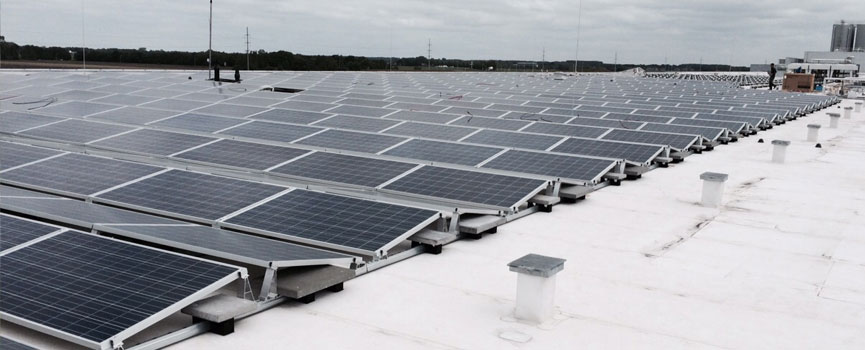
Installing solar panels on a flat roof involves a few key steps. First, set up concrete blocks that will act as the base for the mounting structures. Next, attach aluminum or steel mounting structures to these concrete blocks. Once the mounting structures are in place, you can fix the solar panels onto them using rails, mid clamps, and end clamps.
After the solar panels are secured on the mounting structures, the next step is to wire them as per the design of the solar PV strings. This involves connecting the male MC4 connector of one panel to the female MC4 connector of the adjacent panel. Each string of panels is then connected to the inverter.
Understanding the nuances of a flat roof solar mounting system is crucial to avoid errors during installation. MIBET offers a specialized flat roof racking system that requires less ballast and anchoring, capable of meeting challenging design specifications. Our rail-based system offers structural support with adaptable mounting options for flat roofs.
What Kind of Return Can You Anticipate from Your Solar Panels?
The cost and ROI of installing solar panels depend on various factors, including your location, climate, and available financial incentives. In the US, for instance, the average cost per watt generated ranges from $2.60 to $3.20.
Your annual savings will depend on your electricity consumption and whether you sell excess power back to the grid. However, most flat roof solar panels typically payback their installation costs within seven to nine years. Considering their expected lifespan of 25 years, solar panels offer significant long-term financial benefits.
